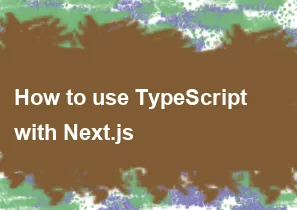How to use TypeScript with Next.js

Using TypeScript with Next.js is a great way to enhance type safety and improve the development experience in your Next.js projects. Here's a step-by-step guide on how to set up and use TypeScript with Next.js:
Step 1: Create a Next.js Project
If you don't already have a Next.js project, you can create one using the following command:
bashnpx create-next-app my-nextjs-app
cd my-nextjs-app
Step 2: Add TypeScript Dependencies
Next, you need to add TypeScript and its types for React to your project. Run the following command in your project directory:
bashnpm install --save-dev typescript @types/react @types/node
Step 3: Initialize TypeScript Configuration
Initialize a tsconfig.json file in the root of your project. You can create one manually or use the TypeScript CLI:
bashnpx tsc --init
This will generate a default tsconfig.json file. You may need to tweak it based on your project requirements.
Step 4: Rename Files to Use TypeScript Extensions
Rename your existing .js and .jsx files to use the .ts and .tsx extensions. For example, if you have a file named index.js, rename it to index.tsx.
Step 5: Update package.json
Update your package.json file to include a "scripts" entry for running TypeScript files:
json"scripts": {
"dev": "next dev",
"build": "next build",
"start": "next start",
"type-check": "tsc --noEmit",
"lint": "eslint . --ext .tsx,.ts"
},
This includes the "type-check" script to run TypeScript type checking and a "lint" script assuming you're using ESLint.
Step 6: Install ESLint and TypeScript ESLint Plugin
If you're not already using ESLint, install it along with the TypeScript ESLint plugin:
bashnpm install --save-dev eslint @typescript-eslint/parser @typescript-eslint/eslint-plugin
Step 7: Configure ESLint
Create an .eslintrc.js file in the root of your project with the following content:
javascriptmodule.exports = {
parser: '@typescript-eslint/parser',
plugins: ['@typescript-eslint'],
extends: [
'plugin:@typescript-eslint/recommended',
'next',
'next/core-web-vitals',
],
};
Step 8: Update Component and Page Files
Update your React components and Next.js pages to use TypeScript syntax. For example, if you have a file index.tsx, it might look like this:
tsx// pages/index.tsx
import React from 'react';
const HomePage: React.FC = () => {
return (
<div>
<h1>Hello Next.js with TypeScript</h1>
</div>
);
};
export default HomePage;
Step 9: Run Your Next.js App
You can now run your Next.js app with TypeScript support using:
bashnpm run dev
And that's it! Your Next.js project is now set up to use TypeScript. You can continue developing your app with the benefits of TypeScript's static typing.
Remember to refer to the official documentation for Next.js and TypeScript for any additional configuration or updates:
-
Popular Post
- How to implement multi-language support in an Express.js application
- How to handle and optimize for changes in mobile search behavior
- How to optimize for Google's About This Result feature for local businesses
- How to handle CORS in a Node.js application
- How to configure Laravel Telescope for monitoring and profiling API requests
- How to use Vue.js with a UI framework (e.g., Vuetify, Element UI)
- How to create a command-line tool using the Commander.js library in Node.js
- How to implement code splitting in a React.js application
- How to use the AWS SDK for Node.js to interact with various AWS services
- How to use the Node.js Stream API for efficient data processing
- How to implement a cookie parser middleware in Node.js
- How to implement WebSockets for real-time communication in React
-
Latest Post
- How to implement a dynamic form with dynamic field styling based on user input in Next.js
- How to create a custom hook for handling user interactions with the browser's device motion in Next.js
- How to create a custom hook for handling user interactions with the browser's battery status in Next.js
- How to implement a dynamic form with dynamic field visibility based on user input in Next.js
- How to implement a dynamic form with real-time collaboration features in Next.js
- How to create a custom hook for handling user interactions with the browser's media devices in Next.js
- How to use the useSWRInfinite hook for paginating data with a custom loading indicator in Next.js
- How to create a custom hook for handling user interactions with the browser's network status in Next.js
- How to create a custom hook for handling user interactions with the browser's location in Next.js
- How to implement a dynamic form with multi-language support in Next.js
- How to create a custom hook for handling user interactions with the browser's ambient light sensor in Next.js
- How to use the useHover hook for creating interactive image zoom effects in Next.js